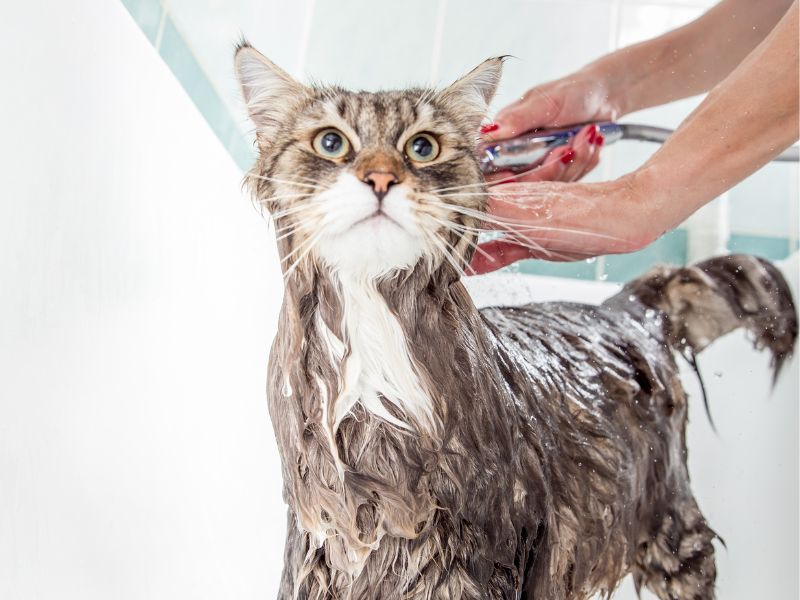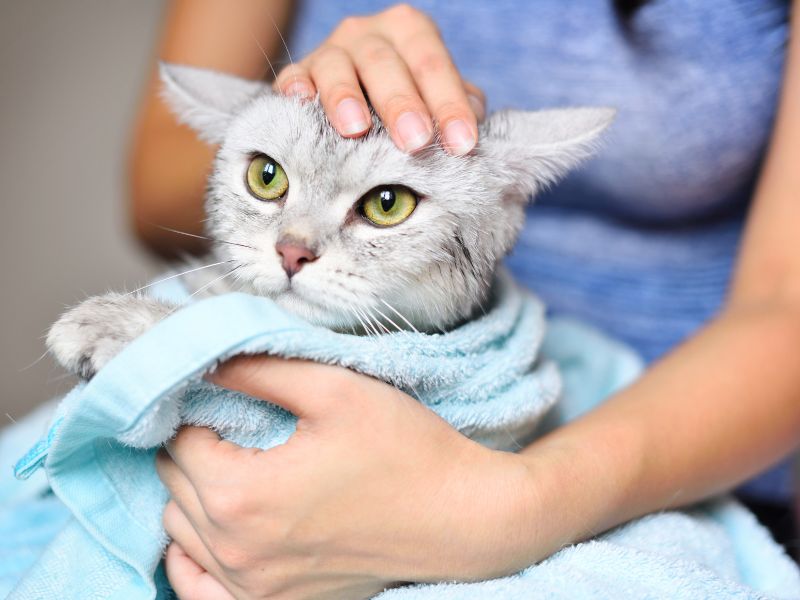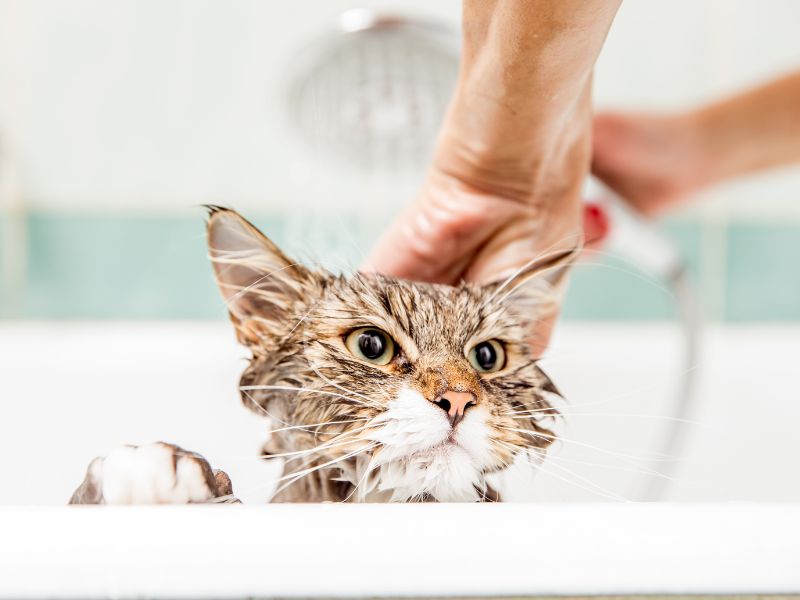Are you a cat owner who dreads bath time? You’re not alone. Bathing a cat can be a daunting task, but with the right knowledge and approach, it doesn’t have to be a nightmare. In this step-by-step guide, we will walk you through the process of bathing a cat and help you make it a stress-free experience for both you and your furry friend. From preparing the bathing area to handling your cat with care, we’ll cover everything you need to know. Discover the best techniques for calming your cat, choosing the right shampoo, and ensuring a thorough clean without causing discomfort. With our expert tips and tricks, you’ll be able to conquer the challenge of bathing your cat with confidence. So, get ready to master the art of cat bathing and keep your feline friend fresh and clean.
Why Is Bathing a Cat Necessary?
Bathing a cat is an essential part of their grooming routine. While cats are known for being meticulous self-groomers, there are instances where a bath is necessary. For example, if your cat gets into something sticky or dirty, a bath can help remove the substance and prevent them from ingesting it while grooming themselves. Additionally, some cats may develop skin conditions that require regular bathing to keep their skin clean and healthy. Bathing also helps to reduce shedding and control allergies in some individuals. However, it’s important to note that not all cats enjoy bathing, so it’s crucial to approach the process with patience and understanding.
Cats have a natural aversion to water, which is rooted in their evolutionary history as desert-dwelling animals. They have a dense coat that acts as insulation and repels water, making them highly resistant to getting wet. This aversion can make bathing a cat a challenging task, but with the right techniques, it can become a manageable and even enjoyable experience for both you and your cat. In the following sections, we will guide you through the process, step by step, to ensure a successful bath time for your feline friend.
Understanding Your Cat’s Behavior and Preferences
Before diving into the actual bathing process, it’s essential to understand your cat’s behavior and preferences. Cats are creatures of habit, and any disruption to their routine can cause stress and anxiety. Therefore, it’s important to approach bathing with sensitivity and respect for your cat’s comfort. Take the time to observe your cat’s reactions to different situations and gradually introduce them to water to help them become more accepting of the process.
Start by creating positive associations with water. Leave a shallow dish of water out for your cat to explore and play with at their own pace. You can also offer treats or praise while they are near the water to create positive associations. Additionally, provide your cat with a comfortable and secure space in the bathroom where they can retreat if they feel overwhelmed. This will help them feel more at ease during the bathing process.
Preparing For the Cat Bath
To ensure a smooth and stress-free bathing experience, it’s important to prepare the bathing area and gather all the necessary supplies beforehand. This will help you stay organized and minimize any potential disruptions during the bathing process. Here’s what you’ll need:
- A suitable bathing area: Choose a location that is easy to clean and has a non-slip surface. A sink, bathtub, or large basin can work well, depending on the size of your cat. Make sure the area is warm, draft-free, and free of any hazards that could cause injury to your cat.
- Cat-friendly shampoo: Use a shampoo specifically formulated for cats. Human shampoos can be too harsh and may irritate your cat’s skin. Look for shampoos that are gentle, hypoallergenic, and free of any harmful chemicals. Consult your veterinarian if you have any concerns or if your cat has specific skin conditions that require specialized products.
- Towels: Have a few soft towels ready to dry your cat after the bath. Avoid using a hairdryer, as the noise and heat can be distressing to cats. Opt for a gentle towel-drying method instead.
- Brush: A brush or comb will help remove any tangles or mats from your cat’s fur before the bath. This will make the bathing process easier and prevent further discomfort for your cat.
- Treats and rewards: Keep some treats or rewards nearby to offer positive reinforcement during and after the bath. This will help your cat associate the bathing experience with something pleasant.

Creating A Calm and Comfortable Environment
Once you have gathered all the necessary supplies, it’s time to create a calm and comfortable environment for your cat. Remember, cats are sensitive to their surroundings, so it’s important to make the bathing area as inviting as possible. Here are some tips to create a stress-free environment:
- Minimize distractions: Turn off any loud noises, such as the TV or radio, and ensure that the bathroom door is closed to prevent other pets or family members from interrupting the bathing process.
- Use a non-slip mat: Place a non-slip mat in the bathing area to provide your cat with a secure footing. This will help prevent any accidents and make your cat feel more comfortable.
- Warm up the room: Make sure the bathroom is warm and draft-free. Cats are sensitive to temperature changes and prefer a warm environment. You can use a space heater or close the bathroom door to retain heat.
Introducing Your Cat to Water Gradually
Now that you have set up the bathing area and created a calm environment, it’s time to introduce your cat to water gradually. Remember, patience is key during this process, as cats may feel apprehensive about getting wet. Here’s how to introduce your cat to water in a gentle and gradual manner:
- Start with a dry bath: Begin by getting your cat used to the sensation of being touched and handled. Gently brush your cat’s fur, paying extra attention to areas that are prone to matting or dirt accumulation. This will help your cat become comfortable with your touch and create a positive association with grooming.
- Use a damp cloth: Once your cat is comfortable with being touched, introduce a damp cloth to mimic the sensation of water. Start by gently wiping your cat’s fur with the damp cloth, gradually increasing the level of moisture. Observe your cat’s reaction and proceed at a pace that they are comfortable with.
- Gradually introduce water: When your cat is comfortable with the damp cloth, you can start introducing water. Use a handheld spray nozzle or a cup filled with lukewarm water to wet your cat’s fur. Start from the back and work your way towards the head, avoiding the face and ears. Be mindful of your cat’s reactions and adjust the water pressure accordingly.
Choosing A Cat-Friendly Shampoo
Selecting the right shampoo is crucial for a successful and comfortable bathing experience for your cat. Cat-friendly shampoos are specifically formulated to be mild and gentle on their skin, preventing any irritation or allergic reactions. Here are some factors to consider when choosing a shampoo:
- Hypoallergenic: Opt for a hypoallergenic shampoo that is free of any harsh chemicals or fragrances. This will minimize the risk of skin irritations or allergic reactions.
- pH-balanced: Look for a shampoo that is pH-balanced for cats. The natural pH of a cat’s skin is different from that of humans, so using a shampoo with the appropriate pH level will help maintain a healthy balance.
- Medicated shampoos: If your cat has specific skin conditions, your veterinarian may recommend a medicated shampoo. These shampoos are designed to target and alleviate specific skin issues, such as dryness, itchiness, or fungal infections. Follow your veterinarian’s instructions when using medicated shampoos.
Proper Techniques for Bathing a Cat
Now that you have everything prepared, and your cat is familiar with water, it’s time to start the actual bathing process. Follow these proper techniques to ensure a thorough clean without causing discomfort to your cat:
- Gently wet your cat: Using the handheld spray nozzle or a cup filled with lukewarm water, wet your cat’s fur from the back towards the tail. Avoid wetting the face and ears, as cats are particularly sensitive in these areas.
- Apply the shampoo: Apply a small amount of cat-friendly shampoo to your hands and gently massage it into your cat’s fur. Start from the back and work your way towards the tail, ensuring that the shampoo reaches the skin. Be careful to avoid the eyes, nose, and mouth.
- Rinse thoroughly: Thoroughly rinse your cat’s fur with lukewarm water, making sure to remove all traces of shampoo. Any residue left behind can cause skin irritations and discomfort for your cat. Take your time and ensure that all the shampoo is rinsed out completely.

See Also: How to Keep Your Cat Safe Indoors
Drying And Grooming Your Cat After the Bath
Once you have finished bathing your cat, it’s important to dry and groom them properly to prevent any discomfort or health issues. Here’s how to dry and groom your cat after the bath:
- Use a towel to dry your cat: Gently wrap your cat in a soft towel and pat them dry. Avoid rubbing vigorously, as this can cause tangling or matting of the fur. Pay extra attention to the ears, paws, and tail, as these areas tend to retain moisture.
- Allow your cat to air dry: If your cat tolerates it, you can allow them to air dry in a warm, draft-free room. Make sure they have access to a comfortable space where they can relax and dry off at their own pace.
- Gently comb or brush your cat’s fur: Once your cat is completely dry, use a comb or brush to remove any tangles or mats that may have occurred during the bath. This will help prevent further discomfort or skin issues.
Dealing With Common Challenges and Concerns
Bathing a cat can come with its fair share of challenges and concerns. Here are some common issues that cat owners may encounter during the bathing process, along with tips on how to address them:
- Scratching: Cats may scratch or try to escape when they are uncomfortable or anxious. To prevent scratching, make sure your cat’s nails are trimmed before the bath. You can also use a towel or washcloth to gently restrain your cat if necessary. However, never force your cat to stay in the water if they are excessively distressed or agitated. It’s important to prioritize their well-being and comfort.
- Aggression: Some cats may become aggressive or defensive during the bathing process. If your cat displays aggressive behavior, such as hissing, growling, or biting, it’s best to consult a professional groomer or veterinarian for assistance. They can provide guidance on handling aggressive cats and ensure the safety of both you and your cat.
Tips For Making Future Baths Easier
With each successful bath, you’ll become more experienced and confident in your cat bathing abilities. Here are some additional tips to help make future baths easier:
- Establish a routine: Cats thrive on routine, so try to establish a regular bathing schedule. This will help your cat become familiar with the process and reduce their anxiety.
- Positive reinforcement: Continuously reward your cat with treats and praise during and after the bath. This will reinforce positive associations with bathing and make future baths more enjoyable for your cat.
- Keep it short and sweet: Cats have a limited attention span, so keep the bathing process as short and efficient as possible. This will help prevent your cat from becoming stressed or overwhelmed.
When To Seek Professional Grooming Assistance
While bathing your cat at home can be a rewarding experience, there may be instances where professional grooming assistance is necessary. Here are some situations where it’s best to seek the help of a professional groomer:
- Aggressive behavior: If your cat consistently displays aggressive behavior during baths and it becomes unmanageable, it’s best to consult a professional groomer or veterinarian. They have the expertise and experience to handle difficult or aggressive cats safely.
- Specific medical conditions: If your cat has specific medical conditions or skin issues that require specialized care, a professional groomer can provide the necessary expertise and treatment.
Conclusion
Bathing a cat doesn’t have to be a nightmare. With the right knowledge, approach, and preparation, you can turn bath time into a stress-free experience for both you and your furry friend. By understanding your cat’s behavior and preferences, creating a calm and comfortable environment, and using the proper techniques, you can successfully bathe your cat without causing discomfort or distress. Remember to be patient, use gentle and cat-friendly products, and provide positive reinforcement throughout the process. With practice and consistency, you’ll become a pro at bathing your cat, ensuring they stay fresh, clean, and healthy. So, embrace the challenge, and make bath time a bonding experience with your feline companion.

